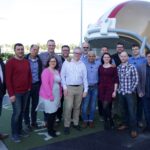|
|
This video is part of the appearance, “NetApp Presents at Storage Field Day 15“. It was recorded as part of Storage Field Day 15 at 10:30-12:30 on March 8, 2018.
Watch on YouTube
Watch on Vimeo
Santosh Rao, Senior Technical Director of Workloads and Ecosystem at NetApp, provides a comprehensive architectural overview of NetApp’s data pipeline strategy during Storage Field Day 15. The discussion begins with a recognition of the challenges faced by legacy data architectures, particularly their inefficiencies and limitations in handling modern analytics workloads. NetApp is actively extending its data pipeline capabilities to operate effectively from the edge to the core and up to the cloud. This transition aims to address the data dynamics in legacy systems by accommodating new-age applications like NoSQL databases and big data solutions, while also considering the implications of cloud-facing architectures, and the fluctuating cost implications of cloud storage.
Rao highlights the shifting landscape regarding enterprise installations, noting a departure from traditional architectures, such as those built around VMware, towards leaner systems utilizing Linux and KVM. This shift acknowledges the growing influence of cloud computing and the emergence of the edge as critical data sources. However, challenges remain, particularly the prohibitive costs and administrative burdens of maintaining multiple copies of data across different systems, which is often unsustainable as data volumes grow. NetApp identifies a significant opportunity to step in as an intermediary player that ensures data fluidity and resource efficiency, enabling enterprises to leverage cloud advantages without being locked into a single vendor or facing exorbitant data management costs.
In his presentation, Rao also discusses the evolving needs of data systems at the edge, showcasing innovations and partnerships pivotal for enhancing NetApp’s presence in this domain. For instance, NetApp’s engagement with vector data and solutions like ONTAP Select demonstrates the company’s strategy to empower edge computing while synchronizing it with core and cloud resources. This approach not only signifies NetApp’s strategic neutrality across different platform ecosystems but underscores its commitment to optimizing data handling across diverse operational landscapes. Through AI and machine learning capabilities, particularly in real-time analytics and low-latency applications, NetApp aims to deliver a robust architecture that supports modern data-driven requirements, thus resonating with both enterprise needs and industry trends.
Personnel: Santosh Rao








